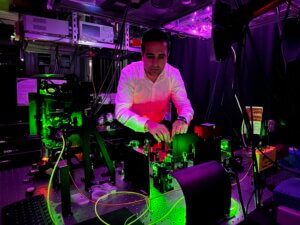
Abdolreza Pasharavesh with the experimental setup the group is now developing to test their theories.
Olivia Woodman and Abdolreza Pasharavesh, graduate students at IQC, together with Dr. Michal Bajcsy and Dr. Christopher Wilson, faculty members at IQC and Waterloo’s Department of Electrical and Computer Engineering, have developed a promising model to detect these photons by making use of the light-sensitive properties of a point defect found in the lattice structure of diamond. In its perfect form, diamond consists of only carbon atoms, however a defect called a nitrogen-vacancy (NV) center can occur if a nitrogen atom takes the place of a carbon atom within the diamond crystal’s structure while the neighboring site is left empty. NV centers, which can make a diamond appear pink in colour, are known for their unique interactions with both microwave photons and optical photons, making them attractive for various applications in quantum technology such as communications, sensing, and fundamental research.
For their proposal, the researchers envision a device in which microwave photons interacting with the defects in diamond change the properties of an optical resonator (cavity). “First we need to confine the photons in electromagnetic cavities,” says Pasharavesh. “Because the level of light given off by a single photon is so low, we use the cavities as a mechanism to enhance the interaction between the photons and our quantum emitter.” The NV center is coupled to an optical cavity and a coplanar waveguide (CPW), a structure that consists of a conductive material, like a strip of metal, on a ground plane that acts as a barrier on the sides and underneath. CPWs efficiently guide and transmit microwave signals along a specific path without them spreading out and dissipating.
Read the full story on the IQC website.
